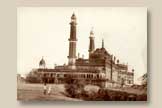Lucknow, the capital of Uttar Pradesh stands on the river Gomati. The Nawabs of Oudh acquired this territory when they wrested power from the Mughals .The creator of Lucknow was Asaf-ud-dowlah, a great patron of Arts. Like previous rulers of Oudh he added several mosques and palaces including the Residency which saw an 87 day siege at the time of the Mutiny (1857) The Great Imambara is another landmark – its main hall is 50 feet high with no supporting pillars. At one time it was the largest vaulted structure in the world. Beyond it is a labrinyth of corridors and galleries; from the top is visible a striking view of the city. Lucknow developed its own style of architecture during the 18th & 19th centuries, a blend of ornate brick & stucco Mughal style and European traits like triangular pediments, round arches and Corinthian capitals. Lucknow is known for its culture, handicrafts, embroidery and as the traditional home of Hindustani classical music and dance. |
||



